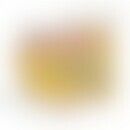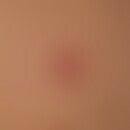Synonym(s)
Beare Syndrome; Galewsky disease; Torsion Hair; Trichokinesis; Trichotortosis; twisted hair; Twisted hair
HistoryThis section has been translated automatically.
Schulz, 1900; Ronchese, 1932
DefinitionThis section has been translated automatically.
Autosomal dominant or autosomal recessive, but apparently also acquired form of hair malformation with mostly flattened hairs that rotate at angles of 90°, 180° or 360° around their longitudinal axis. It is usually first observed in childhood.
You might also be interested in
EtiopathogenesisThis section has been translated automatically.
Unknown; occurring in the context of ectodermal syndromes.
ManifestationThis section has been translated automatically.
Occurs mainly in girls with fine light hair, aged 2 to 5 years. A postpubescent variant, in which mental retardation occurs simultaneously, is described as Beare's syndrome.
LocalizationThis section has been translated automatically.
In childhood on the entire scalp hair, later mainly in the occipital and temporal region.
ClinicThis section has been translated automatically.
- Circumscribed herd with peculiarly shimmering (due to different reflections of light in the twisted areas), twisted, dry, brittle, thin hairs, which rarely grow longer than 4-6 cm.
- aspect of the circumscribed hypotrichosis.
- The eyebrows may also be affected.
- Often an accompanying keratosis follicularis is present.
- In individual cases combined with ectodermal dysplasia or hereditary deafness ( Björnstad syndrome), in Netherton syndrome and Monilethrix syndrome. Also occurring in combination with steatocystoma multiplex.
DiagnosisThis section has been translated automatically.
Microscopic: rotation of the hairs by 90 ° or 180 ° around their longitudinal axis at intervals of 2-10 mm; band-shaped flattening of the hairs.
TherapyThis section has been translated automatically.
A causal therapy is not known. Extensive regression until the hair malformation disappears completely after puberty is possible.
Note(s)This section has been translated automatically.
Most people experience sporadic hair twists, increasingly as a result of hair cosmetic procedures. Physiologically, they are found in underarm and genital hair.
LiteratureThis section has been translated automatically.
- Beare JM (1952) Congenital pilar defect showing features of pili tori. Br J Dermatol 64:366-372.
- Dishop MK et al (2009) Pathologic changes of skin and hair in ankyloblepharon-ectodermal defects-cleft lip/palate (AEC) syndrome. Am J Med Genet A.149A:1935-1941
- Pietrzak A et al (2015) Steatocystoma multiplex with hair shaft abnormalities. J Dermatol doi: 10.1111/1346-8138.12837
- Ronchese F (1932) Twisted hairs (pili torti), Arch Derm Syph 26: 98-108
- Srinivas SM et al.(2013) Netherton syndromes with pili torti. Int J Trichology 5:225-226
Incoming links (18)
Acquired progressive hair curvature; Beare syndrome; Björnstad syndrome; Brown falco-landthaler syndrome; Comel-netherton syndrome; Curly hair acquired; Curly hair nevus; Ectodermal dysplasia ; Hair shaft anomalies (overview); Hypotrichosis congenita hereditaria marie unna; ... Show allOutgoing links (7)
Björnstad syndrome; Ectodermal dysplasia ; Hypotrichosis; Keratosis pilaris; Monilethrix; Netherton syndrome; Steatocystoma multiplex;Disclaimer
Please ask your physician for a reliable diagnosis. This website is only meant as a reference.







